Hippopotamus
| Hippopotamus Temporal range:
| |
|---|---|
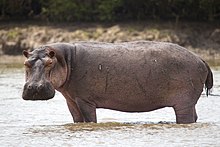
| |
| A hippopotamus in Saadani National Park, Tanzania | |
| Scientific classification | |
| Domain: | Eukaryota |
| Kingdom: | Animalia |
| Phylum: | Chordata |
| Class: | Mammalia |
| Order: | Artiodactyla |
| Family: | Hippopotamidae |
| Genus: | Hippopotamus |
| Species: | H. amphibius
|
| Binomial name | |
| Hippopotamus amphibius | |
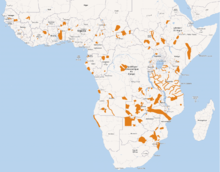
| |
| Current distribution of the hippopotamus | |
The hippopotamus (
After
Hippos inhabit rivers, lakes, and
(canine teeth).Etymology
The
Taxonomy and origins
Classification
The modern hippopotamus and the
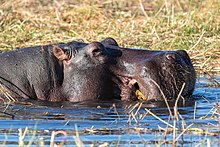
Five subspecies of hippos have been described based on morphological differences in their skulls as well as differences in geographical range:[8]: 3 [9][10][11]
- H. a. amphibius – (the nominate subspecies) ranges from Gambia east to Ethiopia and then south to Mozambique and historically ranged as far north as Egypt; its skull is distinguished by a moderately reduced preorbital region, a bulging dorsal surface, elongated mandibular symphysisand larger chewing teeth.
- H. a. kiboko – found in Kenya and Somalia; was noted to be smaller and more lightly coloured than other hippos with wider nostrils, somewhat longer snout and more rounded and relatively raised orbits with the space between them being incurved.
- H. a. capensis – found in Zambia and South Africa; distinguished by wider orbits.
- H. a. tschadensis – ranges between Chad and Niger; featured a slightly shorter but broader face, and pronounced, forward-facing orbits.
- H. a. constrictus – ranged from the southern ; skull characterised by a thicker preorbital region, shorter snout, flatter dorsal surface, reduced mandibular symphysis and smaller chewing teeth.
The suggested subspecies above were never widely used or validated by field biologists; the described morphological differences were small enough that they could have resulted from simple variation in nonrepresentative samples.[8]: 2 A study examining mitochondrial DNA from skin biopsies taken from 13 sampling locations found "low, but significant, genetic differentiation" among H. a. amphibius, H. a. capensis, and H. a. kiboko. Neither H. a. tschadensis nor H. a. constrictus have been tested.[10]
Evolution

Until 1909,
| Artiodactyla
|
|

The most recent theory of the origins of Hippopotamidae suggests hippos and whales shared a common semiaquatic ancestor that branched off from other artiodactyls around 60 million years ago.[14][16] This hypothesised ancestral group likely split into two branches again around 54 million years ago.[13]
One branch would
A rough evolutionary lineage of the hippo can thus be traced from Eocene and

Extinct species
Three species of Malagasy hippopotamus became extinct during the Holocene on Madagascar, the last of them within the past 1,000 years. The Malagasy hippos were smaller than the modern hippo, a likely result of the process of insular dwarfism.[24] Fossil evidence indicates many Malagasy hippos were hunted by humans, a factor in their eventual extinction.[24] Isolated individual Malagasy hippos may have survived in remote pockets; in 1976, villagers described a living animal called the kilopilopitsofy, which may have been a Malagasy hippo.[25]
Characteristics
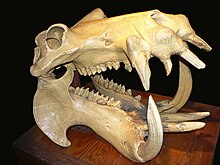
The hippopotamus is a megaherbivore and is exceeded in size among land animals only by elephants and some rhinoceros species. The mean adult weight is around 1,480 kg (3,260 lb) for bulls and 1,365 kg (3,009 lb) for cows. Exceptionally large males have been recorded reaching 2,660 kg (5,860 lb).[31] Male hippos appear to continue growing throughout their lives, while females reach maximum weight at around age 25.[32] Hippos measure 2.90 to 5.05 m (9.5 to 16.6 ft) long,[33] including a tail of about 35 to 56 cm (1.15 to 1.84 ft) in length and 1.30 to 1.65 m (4.3 to 5.4 ft) tall at the shoulder,[34][35] with males and females ranging 1.40 to 1.65 m (4.6 to 5.4 ft) and 1.30 to 1.45 m (4.3 to 4.8 ft) tall at the shoulder respectively.[35] The species has a typical head-body length of 3.3–3.45 m (10.8–11.3 ft) and an average standing height of 1.4 m (4.6 ft) at the shoulder.[36]
Hippos have barrel-shaped bodies with short tails and legs, and an hourglass-shaped skull with a long snout.

The hippo's jaw is powered by huge masseter and digastric muscles which give them large, droopy cheeks.[40]: 259 The jaw hinge allows the animal to open its mouth at almost 180°.[8]: 17 A folded orbicularis oris muscle allows the hippo to attain an extreme gape without tearing any tissue.[42] On the lower jaw, the incisors and canines grow continuously, the former reaching 40 cm (1 ft 4 in), while the latter can grow to up to 50 cm (1 ft 8 in). The lower canines are sharpened through contact with the smaller upper canines.[37] The canines and incisors are used mainly for combat instead of feeding. Hippos rely on their flattened, horny lips to grasp and pull grasses which are then ground by the molars.[40]: 259, 263 The hippo is considered to be a pseudoruminant; it has a complex three-chambered stomach, but does not "chew cud".[8]: 22

Hippo skin is 6 cm (2 in) thick across much of its body with little hair.[37][40]: 260 The animal is mostly purplish-grey or blue-black, but brownish-pink on the underside and around the eyes and ears.[40]: 260 Their skin secretes a natural, red-coloured sunscreen substance that is sometimes referred to as "blood sweat" but is neither blood nor sweat. This secretion is initially colourless and turns red-orange within minutes, eventually becoming brown. Two highly acidic pigments have been identified in the secretions; one red (hipposudoric acid) and one orange (norhipposudoric acid), which inhibit the growth of disease-causing bacteria and their light-absorption profile peaks in the ultraviolet range, creating a sunscreen effect.[43][44] Regardless of diet, all hippos secrete these pigments so food does not appear to be their source; rather, they may be synthesised from precursors such as the amino acid tyrosine.[44] This natural sunscreen cannot prevent the animal's skin from cracking if it stays out of water too long.[45]
The testes of the males do not fully descend and a scrotum is not present. In addition, the penis retracts into the body when not
A hippo's lifespan is typically 40 to 50 years.
Distribution and status


Hippopotamus amphibius arrived in Europe around 560-460,000 years ago, during the Middle Pleistocene.
Archaeological evidence exists of its presence in the
Genetic evidence suggests common hippos in Africa experienced a marked population expansion during or after the
As of 2017, the IUCN Red List drawn up by the International Union for Conservation of Nature (IUCN) lists the species as vulnerable, with a stable population estimated between 115,000 and 130,000 animals.[1] The hippo population has declined most dramatically in the Democratic Republic of the Congo.[63] By 2005, the population in Virunga National Park had dropped to 800 or 900 from around 29,000 in the mid-1970s.[64] This decline is attributed to the disruptions caused by the Second Congo War.[64] The poachers are believed to be Mai-Mai rebels, underpaid Congolese soldiers, and local militia groups.[64][65] Reasons for poaching include the belief hippos are harmful to society, as well as financial gain.[66] As of 2016, the Virunga hippo population appears to have increased again, possibly due to better protection from park rangers, who have worked with local fishermen.[67] The sale of hippo meat is illegal, but black-market sales are difficult for Virunga National Park officers to track.[65][66] Hippo meat is highly valued in some areas of central Africa and the teeth may be used as a replacement for elephant ivory.[68]
A population of hippos exists in Colombia, descended from captive individuals that escaped from Pablo Escobar's estate after his death in 1993. Their numbers grew to 100 by the 2020s and ecologists believe the population should be eradicated, as they are breeding rapidly and are an increasing menace to humans and the environment. Attempts to control them include sterilisation and culling.[69]
Behaviour and ecology
Hippos are
Hippos spend most the day in water to stay cool and hydrated. Just before night begins, they leave the water to forage on land. Hippos usually trot to move quickly on land and can gallop at 30 km/h (19 mph) when needed. They are incapable of jumping but can walk up steep banks. A hippo will travel 3–5 km (1.9–3.1 mi) per night, eating around 40 kg (88 lb) of grass. By dawn, they are back in the water.[37] The hippopotamus sleeps with both hemispheres of the brain resting, as in all land mammals, and usually sleeps on land or in water with the nostrils exposed. Despite this, it may be capable of sleeping while submerged, intermittently surfacing to breathe without waking. They appear to transition between different phases of sleep more quickly than other mammals.[71]
Because of their size and their habit of taking the same paths to feed, hippos can have a significant impact on the land across which they walk, keeping the land clear of vegetation and depressing the ground. Over prolonged periods, hippos can divert the paths of swamps and channels.[72] By defecating in the water, the animals also appear to pass on microbes from their gut, affecting the biogeochemical cycle.[73] On occasion, hippos have been filmed eating carrion, usually near the water. There are other reports of meat-eating and even cannibalism and predation.[74] Hippos' stomach anatomy lacks adaptions to carnivory and meat-eating is likely caused by lack of nutrients or just an abnormal behaviour.[8]: 82–84
Social life
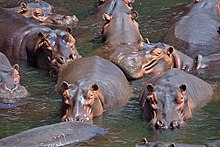
It is challenging to study the interaction of bulls and cows because hippos are not sexually dimorphic, so cows and young bulls are almost indistinguishable in the field.[75] Hippo pods fluctuate but can contain over 100 hippos. Although they lie close together, adults develop almost no social bonds. Males establish territories in water but not land, and these may range 250–500 m (270–550 yd) in lakes and 50–100 m (55–109 yd) in rivers. Territories are abandoned when the water dries up. The bull has breeding access to all the cows in his territory. Younger bachelors are allowed to stay as long as they defer to him. A younger male may challenge the old bull for control of the territory. Within the pods, the hippos tend to segregate by sex and status. Bachelor males lounge near other bachelors, females with other females, and the territorial male is on his own. When hippos emerge from the water to graze, they do so individually.[8]: 4–5, 49–50

Hippos engage in "muck-spreading" which involves defecating while spinning their tails to distribute the faeces over a greater area. Muck-spreading occurs both on land and in water and its function is not well understood. It is unlikely to serve a territorial function, as the animals only establish territories in the water. They may be used as trails between the water and grazing areas.[8]: 5, 51–52 "Yawning" serves as a threat display.[37] When fighting, bulls use their incisors to block each other's attacks and their large canines as offensive weapons.[40]: 259–260 When hippos become over-populated or a habitat shrinks, bulls sometimes attempt infanticide, but this behaviour is not common under normal conditions.[76]
The most common hippo vocalisation is the "wheeze honk", which can travel over long distances in air.[77] This call starts as a high-pitched squeal followed by a deeper, resonant call.[8]: 5 The animals can recognise the calls of other individuals. Hippos are more likely to react to the wheeze honks of strangers than to those they are more familiar with.[77] When threatened or alarmed, they produce exhalations,[37] and fighting bulls will bellow loudly.[8]: 5 Hippos are recorded to produce clicks underwater which may have echolocative properties.[78] They have the unique ability to hold their heads partially above the water and send out a cry that travels through both water and air; individuals respond both above and below water.[79]
Reproduction
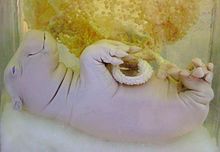
Cows reach sexual maturity at five to six years of age and have a
Mother hippos are very protective of their young, not allowing others to get too close.
Interspecies interactions
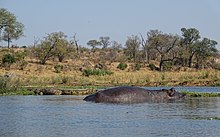
Hippos coexist alongside a variety of large predators in their habitats.
Hippos occasionally visit
The parasitic monogenean flatworm Oculotrema hippopotami infests hippopotamus eyes, mainly the nictitating membrane. It is the only monogenean species (which normally live on fish) documented to live on a mammal.[92]
Hippos and humans
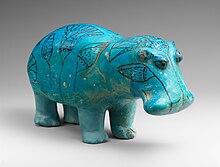
Cut marks on bones of H. amphibius found at
The hippo was also known to the
Attacks on humans
The hippo is considered to be extremely aggressive and has frequently been reported charging and attacking boats.[101] Small boats can easily be capsized by hippos and passengers can be injured or killed by the animals, or drown in the water. In one 2014 case in Niger, a boat was capsized by a hippo and 13 people were killed.[102] Hippos will often raid farm crops if the opportunity arises, and humans may come into conflict with them on these occasions. These encounters can be fatal to either humans or hippos.[103]
According to the
In zoos
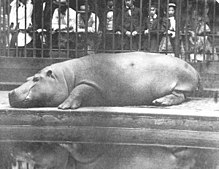
Hippos have long been popular zoo animals. The first record of hippos taken into captivity for display is dated to 3500 BC in Hierakonpolis, Egypt.[105] The first zoo hippo in modern history was Obaysch, who arrived at the London Zoo on 25 May 1850, where he attracted up to 10,000 visitors a day and inspired a popular song, the "Hippopotamus Polka".[106]
Hippos generally breed well in captivity; birth rates are lower than in the wild, but this can be attributed to zoos' desire to limit births, since hippos are relatively expensive to maintain.
Cultural significance

In
Hippos have been the subjects of various

Hippopotamuses were rarely depicted in European art during the Renaissance and Baroque periods, due to less access to specimens by Europeans. One notable exception is Peter Paul Rubens' The Hippopotamus and Crocodile Hunt (1615–1616).[100]: 122–123 Ever since Obaysch inspired the "Hippopotamus Polka", hippos have been popular animals in Western culture for their rotund appearance, which many consider comical.[106] The Disney film Fantasia featured a ballerina hippo dancing to the opera La Gioconda. The film Hugo the Hippo is set in Tanzania and involves the title character trying to escape being slaughtered with the help of local children. The Madagascar films feature a hippo named Gloria.[100]: 128–129 Hippos even inspired a popular board game, Hungry Hungry Hippos.[114]
Among the most famous poems about the hippo is "The Hippopotamus" by T. S. Eliot, where he uses the animal to represent the Catholic Church. Hippos are mentioned in the novelty Christmas song "I Want a Hippopotamus for Christmas" that became a hit for child star Gayla Peevey in 1953. They also featured in the popular "The Hippopotamous Song" by Flanders and Swann.[100]: 128, 136
See also
- American Hippo bill - 1910 bill that proposed the introduction of hippos into Louisiana
- Armley Hippo fossil H. amphibius specimen from England
- Allenton hippopotamus fossil H. amphibius specimen from England
- Owen and Mzee - hippo and tortoise who bonded
- Fiona - hippo born 6 weeks early at the Cincinnati Zoo and Botanical Garden
References
- ^ . Retrieved 19 November 2021.
- ^ "ITIS on Hippopotamus amphibius". Integrated Taxonomic Information System. Archived from the original on 26 August 2014. Retrieved 29 July 2007.
- ^ "hippopotamus". Dictionary.com Unabridged (Online). n.d. Retrieved 9 August 2019.
- Perseus Project.
- ^ "Hippopotamus". Merriam-Webster's Online Dictionary. Retrieved 18 July 2007.
- ^ Harper, Douglas. "hippopotamus". Online Etymology Dictionary.
- ^ "Plural of hippopotamus". Oxford English Dictionary. Archived from the original on 13 October 2008. Retrieved 18 July 2007.
- ^ ISBN 978-0-85661-131-5.
- ^ Lydekker, R (1915). Catalogue of the Ungulate Mammals in the British Museum of Natural History, vol. 4. Vol. 4. British Museum. pp. 389–392.
- ^ PMID 16030528.
- IUCN. 5 (1).
- PMID 26473040.
- ^ PMID 9881471.
- ^ PMID 9159931.
- S2CID 4320261.
- ^ a b c Sanders, Robert (25 January 2005). "Scientists find missing link between the dolphin, whale and its closest relative, the hippo". Science News Daily. Archived from the original on 26 February 2015. Retrieved 8 January 2011.
- ^ PMID 15677331.
- ^ S2CID 83768668.
- PMID 25710445.
- ^ Lihoreau, F. (19 June 2015). "New Fossils from Kenya Precise Hippo Origin". Serious Science. Retrieved 5 June 2021.
- (PDF) from the original on 9 October 2022.
- ^ a b van der Made J, Sahnouni M & Boulaghraief K. 2017. Hippopotamus gorgops from El Kherba (Algeria) and the context of its biogeography. In Proceedings of the II Meeting of African Prehistory: Burgos 15–16 April 2015, Sahnouni M, Semaw S, Rios Garaizar J (eds). CENIEH: Burgos; 135–169.
- S2CID 258024770.
- ^ .
- JSTOR 681820.
- ^ Chaix L, Faure M, Guérin C, Honegger M. Kaddanarti, a Lower Pleistocene Assemblage from Northern Sudan. In: Krzyżaniak L, Kroeper K, Kobusiewicz M, editors. Recent Research into the Stone Age of Northeastern Africa. Poznań: Poznań Archaeological Museum; 2000. p. 33–46.
- PMID 34100541.
- S2CID 244179438.
- .
- ^ Petronio, C. (1995). "Note on the taxonomy of Pleistocene hippopotamuses" (PDF). Ibex. 3: 53–55. Archived from the original (PDF) on 12 September 2008.
- ISBN 9780521426374.
- JSTOR 2401788.
- ^ "Physical Description". Retrieved 22 October 2020.
- ^ "Hippopotamus amphibius". Retrieved 22 October 2020.
- ^ a b "Hippopotamus". Archived from the original on 8 August 2020. Retrieved 22 October 2020.
- ISBN 978-0-7607-1969-5.
- ^ ISBN 978-0-520-08085-0.
- S2CID 51686926.
- ISBN 9780761477280.
- ^ ISBN 978-0-226-43722-4.
- ^ Reidenberg, Joy S (2017). "Terrestrial, semiaquatic, and fully aquatic mammal sound production mechanisms" (PDF). Acoustics Today. 13 (2): 35–43.
- ^ Herring, S. W. (1975). "Adaptations for gape in the hippopotamus and its relatives". Forma et Functio. 8: 85–100.
- ^ Kean, Sam (2018). "Sweating blood". Distillations. 4 (2): 5. Retrieved 20 August 2018.
- ^ S2CID 4404922.
- ISBN 978-0-520-24281-4.
- Mesker Park Zoo. 12 June 2006. Archived from the originalon 27 September 2007. Retrieved 21 June 2007.
- ^ "Celebrate with Donna". Evansville Courier & Press. 12 July 2007. Archived from the original on 16 January 2014. Retrieved 15 July 2007.
- ^ Fears, Danika (3 August 2012). "Goodbye, Donna: World's oldest hippo in captivity dies at 61". Today.com. Archived from the original on 4 June 2013. Retrieved 12 September 2013.
- ^ "Bertha, the world's 'oldest' hippo, dies at 65". BBC News. 10 July 2017. Retrieved 29 November 2020.
- ^ Lentz-Janney, Melanie (15 February 2021). "Our Favorite Homosassa Springs Resident: Lu the Hippo". Authentic Florida. Retrieved 31 January 2024.
- PMID 37992018.
- ^ ISSN 2571-550X.
- S2CID 239713930.
- ^ S2CID 239839913, retrieved 26 January 2024
- ISSN 0305-1838.
- ISSN 0016-7746.
- .
- S2CID 163871070.
- S2CID 163758714.
- ^ )
- ^ "The Hippopotamus Going - Extinction of the huge species at hand". The Sydney Morning Herald. 7 October 1898. Retrieved 14 July 2017.
- ^ "Appendices | CITES". cites.org. Retrieved 13 November 2022.
- Smithsonian Magazine. 1 January 2006. Retrieved 23 January 2007.
- ^ a b c "DR Congo's hippos face extinction". BBC. 13 September 2005. Retrieved 14 November 2005.
- ^ a b Owen, James (24 October 2006). "Hippos Butchered by the Hundreds in Congo Wildlife Park". National Geographic News. Archived from the original on 20 February 2014. Retrieved 11 September 2013.
- ^ a b Sundaram, Anjan (12 September 2005). "Congo's Hippos Fast Disappearing". Toronto Star.
- ^ Delaney, J.; Sautner, S. (3 November 2016). "After a Long Demise Due to Poaching, Virunga's Hippos Climbing Back". Wildlife Conservation Society. Retrieved 25 November 2016.
- ^ Pearce, Fred (2003). "Poaching causes hippo population crash". New Scientist. Retrieved 26 April 2014.
- ^ Charles, Matthew (17 January 2021). "Colombia's rapidly breeding 'cocaine hippos' must be stopped, scientists say". news.yahoo.com. The Telegraph. Retrieved 18 January 2021.
- ^ S2CID 216152807.
- PMID 26588600.
- .
- PMID 34848778.
- ^ Dudley, J. P. (January 1998). "Reports of carnivory by the common hippo Hippopotamus amphibius". South African Journal of Wildlife Research. 28 (2): 58–59.
- S2CID 88102117. Archived from the original(PDF) on 17 June 2010.
- ^ doi:10.1080/08927014.1998.9522857. Archived from the originalon 6 March 2011. Retrieved 11 July 2010.
- ^ (PDF) from the original on 9 October 2022.
- JSTOR 26488527.
- .
- JSTOR 1373731.
- ^ PMID 12270790.
- S2CID 191169281.
- ISBN 978-0-691-15228-8.
- ISBN 978-0-226-73639-6.
- ISBN 978-0-8160-2174-1.
- .
- ISBN 978-0-7153-5272-4.
- ISBN 978-1-4039-8602-3.
- .
- PMID 29769538.
- ^ Yong, Ed (16 May 2018). "Hippos Poop So Much That Sometimes All the Fish Die". The Atlantic. Retrieved 23 June 2021.
- S2CID 53289954.
- .
- .
- S2CID 4312418.
- ISBN 978-9771744399.
- ISBN 978-0-19-521974-6.
- ISBN 978-0253112736.
- ^ Chilvers, H. A. (1931). Huberta Goes South, a Record of the Lone Trek of the Celebrated Zululand Hippopotamus. London: Gordon & Gotch.
- ^ ISBN 9781780237794.
- ^ Thomas, Pete (14 January 2015). "Massive hippo charges safari boat in Malawi, Africa". Pete Thomas Outdoor.
- ^ "Hippopotamus attack kills 13 people, including 12 children, in boat near Niger's capital Niamey". Australian Broadcasting Corporation. 20 November 2014.
- .
- ^ Elder, E. (1849). Smith, W. (ed.). Dictionary of Greek and Roman biography and mythology. Vol. 2. Boston: Charles C. Little & James Brown.
- ^ Rose, M. (2010). "World's first Zoo-Hierakonpolis, Egypt". Archaeology. 63 (1): 25–32.
- ^ a b c Root, N. J. (1993). "Victorian England's Hippomania". Natural History. 103: 34–39.
- S2CID 86295612.
- ISBN 9781576076125.
- ISBN 978-0486231815.
- ISBN 978-1107021662.
- ^ Orans, L. P. (1997). "Scouting in South Africa 1884–1890". Pinetreeweb. Archived from the original on 28 July 2014. Retrieved 29 March 2011.
- ISBN 978-0-19-504645-8.
- ISBN 978-1-86872-456-7.
- ISBN 9780190611859.
External links
- "Hippos: Wildlife summary". African Wildlife Foundation. Archived from the original on 19 November 2010.
- "Hippo Specialist Group of the World Conservation Union". International Union for Conservation of Nature. Archived from the original on 22 November 2014. Retrieved 4 November 2008.
- "11 Things You May Not Know About Ancient Egypt: King Tut may have been killed by a hippopotamus". History. 12 November 2012. Archivedfrom the original on 17 December 2014.

